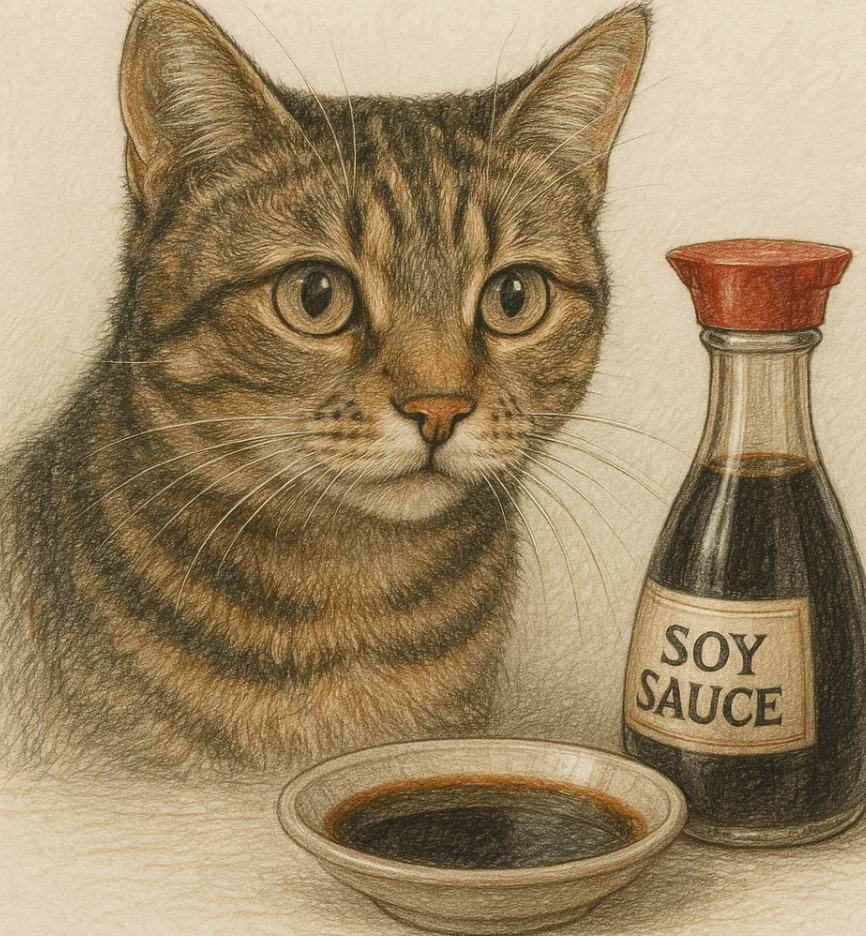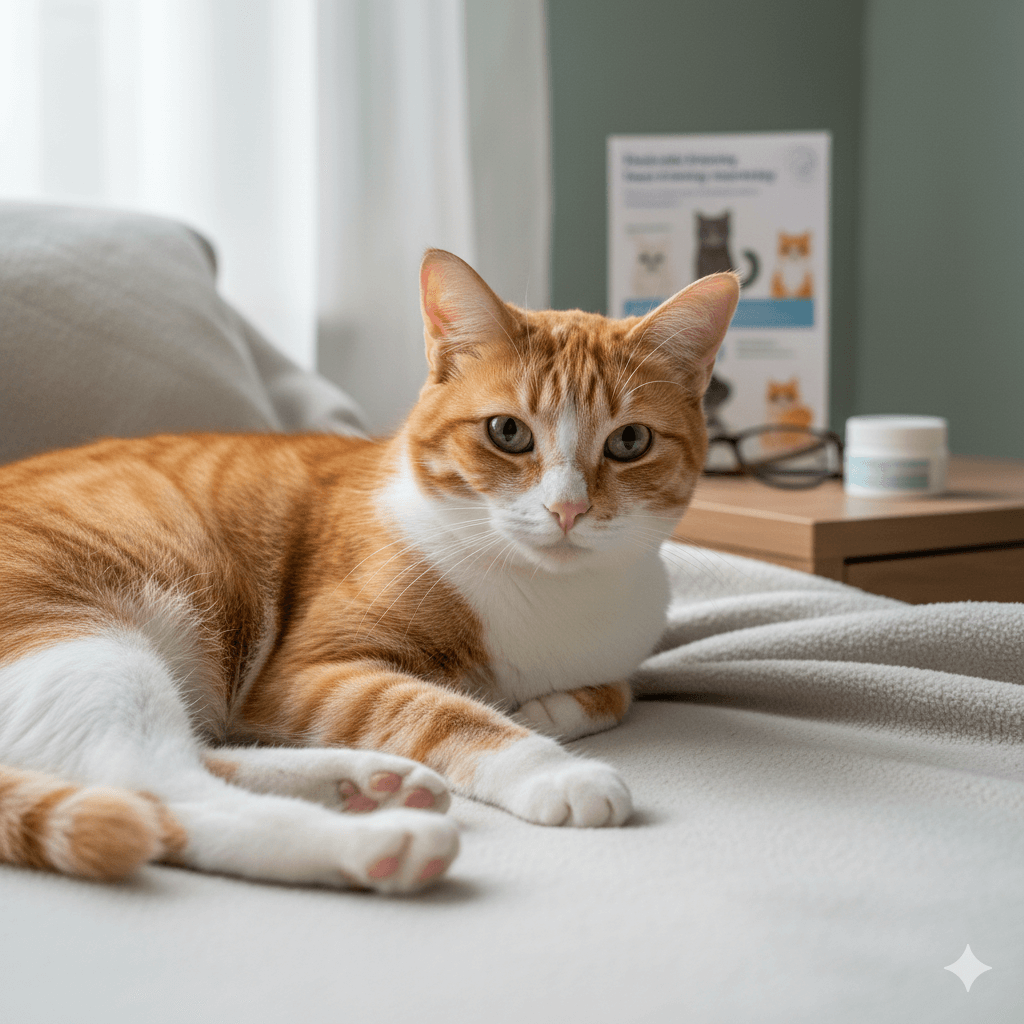Can Cats Eat Soy Sauce?
When it comes to feeding our feline friends, many pet owners wonder whether common human foods are safe for cats. Soy sauce, a staple in many kitchens, often raises questions about its safety for curious kitties who might sneak a taste. While soy sauce is unlikely to be toxic in small amounts, it’s not exactly cat-friendly either. Understanding the potential risks and effects of soy sauce on your cat’s health is crucial to ensuring their well-being. In this blog post, we’ll explore everything you need to know about cats and soy sauce, from its ingredients to safer alternatives.
Potential Risks of Feeding Soy Sauce to Cats
While soy sauce might seem harmless, it contains several ingredients that can be problematic for cats. Here’s why you should think twice before letting your cat lick soy sauce off your plate.
High Sodium Content:
Soy sauce is extremely salty, and excessive sodium can lead to dehydration, kidney issues, or even salt poisoning in cats.Artificial Additives:
Many brands of soy sauce contain preservatives, flavor enhancers, and artificial colors that can upset your cat’s digestive system.Allergic Reactions:
Some cats may be sensitive to soy or wheat, both of which are common ingredients in soy sauce, leading to allergic reactions like itching or swelling.Gastrointestinal Upset:
Even small amounts of soy sauce can cause vomiting, diarrhea, or stomach discomfort due to its strong flavor and high salt content.Not Nutritionally Beneficial:
Soy sauce offers no nutritional value for cats and can disrupt their balanced diet if consumed regularly.
These risks highlight why soy sauce should be avoided as a treat or accidental snack for your feline companion.
Signs Your Cat May Have Eaten Soy Sauce
If your cat accidentally ingests soy sauce, it’s important to monitor them closely for any adverse reactions. Look out for these warning signs that indicate they may be experiencing discomfort or toxicity.
Excessive Thirst or Urination:
High sodium levels can make your cat excessively thirsty, leading to increased urination as their body tries to flush out the excess salt.Vomiting or Diarrhea:
Gastrointestinal distress is a common reaction to soy sauce and may occur shortly after ingestion.Lethargy or Weakness:
Salt poisoning can cause symptoms like weakness, lethargy, or difficulty walking due to electrolyte imbalances.Tremors or Seizures:
In severe cases of sodium toxicity, cats may experience tremors, seizures, or other neurological symptoms.Loss of Appetite:
If your cat refuses to eat after consuming soy sauce, it could indicate nausea or an upset stomach.
Recognizing these signs early allows you to seek veterinary care promptly and prevent further complications.
Check this guide 👉Can Cats Eat Squid? Best 7 Expert Tips!
Check this guide 👉Can Cats Eat Grits? Best 7 Expert Tips!
Check this guide 👉Can Cats Eat Corn Husks? Best 7 Expert Tips!

Safe Alternatives to Soy Sauce | Risks of Unsafe Human Foods for Cats |
|---|---|
Plain cooked chicken (unsalted) | Onions and garlic (found in soy sauce) |
Bone broth (low-sodium, no spices) | Chocolate and caffeine |
Cat-safe treats with natural ingredients | Alcohol and dairy products |
Fresh fruits like blueberries or bananas | Grapes and raisins |
Plain rice or boiled vegetables | Artificial sweeteners like xylitol |
How to Safely Introduce New Foods to Your Cat
While soy sauce isn’t safe for cats, introducing new foods carefully ensures your pet stays healthy and happy. Follow these guidelines to avoid potential hazards.
Start with Small Portions:
Offer tiny amounts of any new food to see how your cat reacts before giving more.Avoid Seasonings and Spices:
Cats have sensitive digestive systems, so plain, unseasoned foods are always best.Consult Your Veterinarian:
Before introducing unfamiliar foods, ask your vet to ensure they’re safe and appropriate.Monitor for Adverse Reactions:
Watch for signs of allergies, digestive upset, or behavioral changes after trying something new.Stick to Cat-Specific Treats:
Commercial cat treats are formulated to meet their dietary needs and are generally safer than human snacks.
By following these steps, you can safely experiment with new foods without compromising your cat’s health.
Tips for Preventing Accidental Ingestion of Harmful Foods
Cats are naturally curious creatures, and accidents can happen when they get into foods they shouldn’t. These tips will help you minimize the risk of your cat consuming harmful substances like soy sauce.
Keep Dangerous Foods Out of Reach:
Store items like soy sauce, onions, and chocolate in secure cabinets where your cat can’t access them.Supervise Mealtime:
Avoid leaving plates of food unattended, especially if your cat has a habit of jumping onto tables or countertops.Teach Boundaries:
Train your cat to stay away from areas where food is prepared or served using positive reinforcement techniques.Use Pet-Proof Trash Cans:
Dispose of leftover food securely to prevent scavenging behavior.Educate Family Members:
Ensure everyone in your household knows which foods are unsafe for cats to avoid accidental sharing.
Taking these precautions reduces the likelihood of your cat encountering harmful foods.
Common Ingredients in Soy Sauce That Are Harmful to Cats
Understanding what makes soy sauce unsafe for cats helps explain why it’s best to avoid it altogether. Here are some key ingredients to watch out for.
Soybeans:
While not inherently toxic, soybeans can cause digestive upset or allergic reactions in sensitive cats.Wheat:
Many soy sauces contain wheat, which some cats may struggle to digest properly.Salt:
The high sodium content poses a significant risk of dehydration and kidney strain.Preservatives:
Chemicals like sodium benzoate can irritate your cat’s stomach or cause long-term health issues.MSG (Monosodium Glutamate):
This flavor enhancer can trigger adverse reactions such as nausea or hyperactivity.
Being aware of these ingredients reinforces the importance of keeping soy sauce away from your cat.
Alternatives to Satisfy Your Cat’s Curiosity About Flavor
If your cat shows interest in trying human foods, there are plenty of safer alternatives that mimic interesting flavors without the associated risks.
Cat Grass:
Provides a safe way for cats to nibble on something green and satisfying.Freeze-Dried Meat Snacks:
These treats offer intense flavors without added salt or spices.Homemade Broth:
A low-sodium, plain broth made from boiling chicken or beef bones can entice your cat’s taste buds.Edible Cat Toys:
Some toys are infused with catnip or other safe flavors to engage their senses.Plain Yogurt Drops:
A small amount of plain yogurt can provide a creamy texture and mild flavor cats enjoy.
These alternatives allow you to indulge your cat’s curiosity while keeping them safe.
How to Handle Food-Related Curiosity in Cats
Cats are naturally drawn to scents and textures, making them curious about the foods we eat. Managing this curiosity involves redirection and education.
Redirect Attention:
Offer a cat-safe toy or treat whenever your cat shows interest in human food.Create a Designated Space:
Set up a specific area for your cat during mealtime to reduce temptation and distractions.Reward Good Behavior:
Praise your cat when they ignore human food, reinforcing positive habits over time.Provide Mental Stimulation:
Engage your cat with interactive toys or puzzles to shift their focus away from food.Be Consistent:
Establish clear rules about food boundaries and stick to them to avoid confusion.
By addressing their curiosity constructively, you can foster a healthier relationship between your cat and food.
Frequently Asked Questions About Cats and Soy Sauce
Is soy sauce toxic to cats?
While not highly toxic, soy sauce contains high sodium levels and additives that can harm cats if consumed in large quantities.
What should I do if my cat eats soy sauce?
Monitor them for symptoms like vomiting, diarrhea, or excessive thirst. Contact your vet immediately if you notice any concerning signs.
Can kittens eat soy sauce?
No, kittens are even more vulnerable to the effects of high sodium and should never consume soy sauce.
Are there any safe seasonings for cats?
Plain herbs like parsley or catnip are safe in moderation, but most seasonings used in human food are not suitable for cats.
How can I satisfy my cat’s curiosity about human food?
Offer cat-safe alternatives like plain cooked meat or specially designed treats to redirect their interest.
Prioritizing Your Cat’s Health Around Human Foods
Feeding your cat properly is essential for their long-term health and happiness. While soy sauce might seem like a harmless condiment, its high sodium content and artificial additives make it unsuitable for feline consumption. By understanding the risks, recognizing warning signs, and taking preventive measures, you can protect your cat from accidental ingestion of harmful foods. Remember, your furry friend relies on you to make the best dietary choices for them—so always prioritize their safety and well-being above all else.
Understanding Mast Cell Tumor in Cats: Best 7 Expert Tips! – Spot signs, understand treatment, and support your cat with confidence.
The Norwegian Buhund Dog: Best 7 Expert Tips! – Discover training, care & history of this lively, loyal Nordic herding breed.
Understanding Status Epilepticus in Cats: Best 7 Expert Tips – Recognize emergency signs, act fast, and protect your cat’s neurological health.
Portuguese Hunting Dog: Best 7 Expert Tips! – Discover this rare Iberian gundog’s history, care, training & ideal lifestyle fit.




